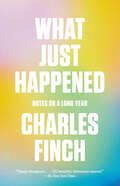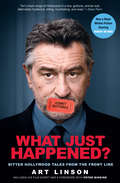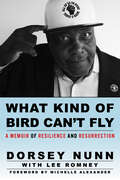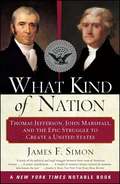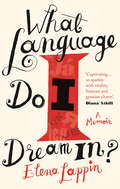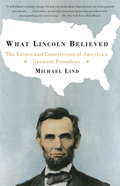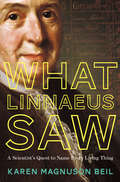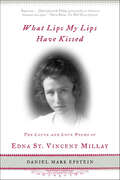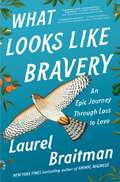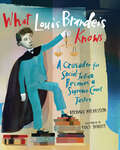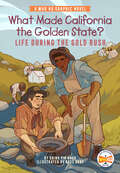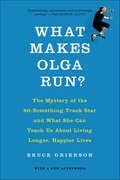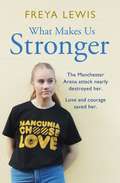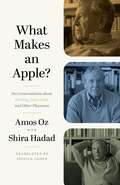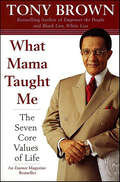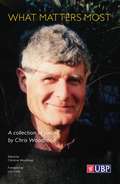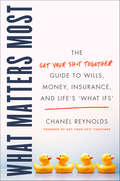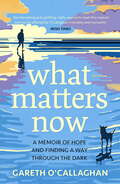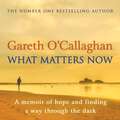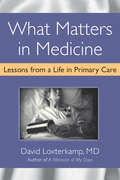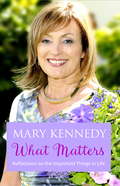- Table View
- List View
What Just Happened: Notes on a Long Year
by Charles FinchWith unwavering humanity and light-footed humor, this intimate account of the interminable year of 2020 offers commentary on the COVID-19 pandemic, protests for racial justice, the U.S. presidential election, and more, all with a miraculous dose of groundedness in head-spinning times. From the award-winning book critic and best-selling author."This book is so funny and so true. Charles Finch unpacks a year of plague, fear, shameless venality, and dizzying stupidity with an irrepressible wit and surgically precise cultural observations. I didn't know how badly I needed exactly this. Maybe you do too?"—Joe Hill, author of Heart-Shaped Box In March 2020, at the request of the Los Angeles Times, Charles Finch became a reluctant diarist: As California sheltered in place, he began to write daily notes about the odd ambient changes in his own life and in the lives around him. The result is What Just Happened. In a warm, candid, welcoming voice, and in the tradition of Woolf and Orwell, Finch brings us into his own world: taking long evening walks near his home in L.A., listening to music, and keeping virtual connections with friends across the country as they each experience the crisis. And drawing on his remarkable acuity as a cultural critic, he chronicles one endless year with delightful commentary on current events, and the things that distract him from current events: Murakami&’s novels, reality television, the Beatles. What Just Happened is a work of empathy and insight, at once of-the-moment and timeless—a gift from one of our culture's most original thinkers.
What Just Happened?: Bitter Hollywood Tales from the Front Line (Books That Changed the World)
by Art LinsonThis film producer’s honest, hilarious behind-the-scenes memoir “details the planning, handholding and power games involved in making movies” (Publishers Weekly).Art Linson has had a hand in producing some of the most unforgettable films of the past half-century—Fast Times at Ridgemont High, The Untouchables, Fight Club—and has worked with some of America’s finest actors and directors. In what the Los Angeles Times calls “a breezy anatomy of ritual humiliation,” his memoir gives us a brutally honest, funny, and comprehensive tour through the horrors of Hollywood. “Art Linson puts a film freak exactly where he or she wants to be: in the Fox screening room during the studio brass’s horrified first look at Fight Club…Linson gives readers a glimpse into a bizarre world where ‘It’s good’ is the absolute worst thing you can say about a movie.” —Entertainment Weekly“A hoot.”—The Philadelphia InquirerIncludes a new interview of Art Linson by Peter Biskind and the screenplay of the film version
What Kind of Bird Can't Fly: A Memoir of Resilience and Resurrection
by Dorsey NunnA decade behind bars spurs fifty powerful years of political and legal battles for freedom and human rights."Whoever wants to assuage their doubts that radical change is possible—from the level of the individual to that of law, culture, and society—should make time to read Dorsey Nunn's extraordinary memoir." —Angela Y. Davis, political activist and author of Are Prisons Obsolete?, Abolition Democracy, and Freedom Is a Constant Struggle"Dorsey Nunn is one of the grand love warriors and freedom fighters of his generation! Don't miss his powerful and poignant story of tragedy and triumph!" —Cornel West"So much of what I've come to know and understand over the years about the second-class status imposed upon people labeled 'criminals' or 'felons' I've learned from Dorsey and the people who comprise All of Us or None, an organization he cofounded. Although I have fancy degrees and Dorsey does not, there’s never been a time in our friendship in which he hasn't been schooling me—not so much in theory, but in practice." —From the foreword by Michelle AlexanderWhen Dorsey Nunn shuffled, shackled like a slave, into the California State carceral system at age nineteen, he could barely read. While caged he received an education he never could have anticipated. His first lesson: Prison had a color scheme, and it didn’t match the larger society. On the inside, guards stoked racial warfare among prisoners while on the outside the machinery of the criminal legal system increasingly targeted poor Black and Brown communities with offenses, real or contrived. Nunn emerged from San Quentin after ten years behind bars, radicalized by his experience and emboldened by the militant wisdom of the men he met there. He poured his heart and mind into liberating all those he left behind, building a nationwide movement to restore justice to millions of system-impacted Americans.In this poignant, wry, and powerful memoir, Nunn links the politics of Black Power to the movements for Black lives and dignified reentry today. His story underscores the power of coalition building, persistence in the face of backlash, and the importance of centering the voices of experience in the fight for freedom—and proves, once and for all, that jailbirds can fly.
What Kind of Nation: Thomas Jefferson, John Marshall, and the Epic Stru
by James F. SimonThe bitter and protracted struggle between President Thomas Jefferson and Supreme Court Chief Justice John Marshall defined the basic constitutional relationship between the executive and judicial branches of government. More than one hundred fifty years later, their clashes still reverberate in constitutional debates and political battles.In this dramatic and fully accessible account of these titans of the early republic and their fiercely held ideas, James F. Simon brings to life the early history of the nation and sheds new light on the highly charged battle to balance the powers of the federal government and the rights of the states. A fascinating look at two of the nation's greatest statesmen and shrewdest politicians, What Kind of Nation presents a cogent, unbiased assessment of their lasting impact on American government.
What Language Do I Dream In?: A Memoir
by Elena LappinTaking its title from a question often asked of polyglots, What Language Do I Dream In? is Elena Lappin's stunning memoir about how language runs throughout memory and family history to form identity. Lappin's life could be described as "five languages in search of an author", and as a multiple émigré, her decision to write in English was the result of many wanderings. Russian, Czech, German, Hebrew, and finally, English: each language is a link to a different piece of Lappin's rich family mosaic and the struggle to find a voice in a language not one's own.From Europe to North America—and back again, via some of the twentieth century's most significant political upheavals—Lappin reconstructs the stories and secrets of her parents and grandparents with the tenderness of a novelist and the eye of a documentary filmmaker. The story of Lappin's identity is unexpectedly complicated by the discovery, in middle age, that her biological father was an American living in Russia. This revelation makes her question the very bedrock of her knowledge of her birth, and adds a surprising twist: suddenly, English may be more than the accidental "home in exile"—it is a language she may have been close to from the very beginning."English is not my mother tongue," writes Elena Lappin, "it is something more valuable: a language I was lucky enough to be able to choose." What Language Do I Dream In? is a wonderful, honest story about love, family, memory, and how they intertwine to form who we are.
What Language Do I Dream In?: A Memoir
by Elena LappinElena Lappin's life could be described as 'five languages in search of an author'. She now lives in London, but she was born in Russia and has lived in Czechoslovakia, Germany, Israel, Canada, and the United States. As a multiple émigré, her decision to write in English was the unexpected result of many wanderings, and this memoir tells the story of finding a voice in a language that is not one's own. Russian, Czech, German, Hebrew, and finally English: how do they, and the family roots and cultures they represent define who she is, and how has adopting English allowed her to be a writer?The story of Lappin's identity is unexpectedly complicated by the discovery, in middle age, that her biological father was an American living in Russia. Their encounter introduces an element of mystery to the search for her roots, and a surprise: suddenly, English is more than the accidental 'home in exile' - it is the language she may have been close to from the very beginning.
What Lincoln Believed: The Values and Convictions of America's Greatest President
by Michael LindFew biographers and historians have taken Lincoln's ideas seriously or placed him in the context of major intellectual traditions. InWhat Lincoln Believed, the most comprehensive study ever written of the thought of America's most revered president, Michael Lind provides a resource to the public philosophy that guided Lincoln as a statesman and shaped the United States. Although he is often presented as an idealist dedicated to political abstractions, Lincoln was a pragmatic politician with a lifelong interest in science, technology, and economics. Throughout his career he was a disciple of the Kentucky senator Henry Clay, whose "American System" of government support for industrial capitalism Lincoln promoted when he served in the Illinois statehouse, the U. S. Congress, and the White House. Today Lincoln is remembered for his opposition to slavery and his leadership in guiding the Union to victory in the Civil War. But Lincoln's thinking about these subjects is widely misunderstood. His deep opposition to slavery was rooted in his allegiance to the ideals of the American Revolution. Only late in his life, however, did Lincoln abandon his support for the policy of "colonizing" black Americans abroad, which he derived from Henry Clay and Thomas Jefferson. Lincoln and most of his fellow Republicans opposed the extension of slavery outside of the South because they wanted an all-white West, not a racially integrated society. Although the Great Emancipator was not the Great Integrationist, he was the Great Democrat. In an age in which many argued that only whites were capable of republican government, Lincoln insisted on the universality of human rights and the potential for democracy everywhere. In a century in which liberal and democratic revolutions against monarchy and dictatorship in Europe and Latin America repeatedly had failed, Lincoln believed that liberal democracy as a form of government was on trial in the American Civil War. "Our popular government has often been called an experiment," Lincoln told the U. S. Congress, insisting that the American people had to prove to the world that "when ballots have fairly, and constitutionally, decided, there can be no successful appeal, back to bullets. " If the United States fell apart after the losers in an election took up arms, then people everywhere might conclude that democracy inevitably led to anarchy and "government of the people, by the people, for the people" might well "perish from the earth. " "He loved his country partly because it was his own country, but mostly because it was a free country. " What Lincoln said of Henry Clay could be said of him as well. InWhat Lincoln Believed, Michael Lind shows the enduring relevance of Lincoln's vision of the United States as a model of liberty and democracy for the world.
What Linnaeus Saw: A Scientist And His Quest To Name And Catalog Every Living Thing
by Karen Magnuson BeilThe globetrotting naturalists of the eighteenth century were the geeks of their day: innovators and explorers who lived at the intersection of science and commerce. Foremost among them was Carl Linnaeus, a radical thinker who revolutionized biology. In What Linnaeus Saw, Karen Magnuson Beil chronicles Linnaeus’s life and career in readable, relatable prose. As a boy, Linnaeus hated school and had little interest in taking up the religious profession his family had chosen. Though he struggled through Latin and theology classes, Linnaeus was an avid student of the natural world and explored the school’s gardens and woods, transfixed by the properties of different plants. At twenty-five, on a solo expedition to the Scandinavian Mountains, Linnaeus documented and described dozens of new species. As a medical student in Holland, he moved among leading scientific thinkers and had access to the best collections of plants and animals in Europe. What Linnaeus found was a world with no consistent system for describing and naming living things—a situation he methodically set about changing. The Linnaean system for classifying plants and animals, developed and refined over the course of his life, is the foundation of modern scientific taxonomy, and inspired and guided generations of scientists. What Linnaeus Saw is rich with biographical anecdotes—from his attempt to identify a mysterious animal given him by the king to successfully growing a rare and exotic banana plant in Amsterdam to debunking stories of dragons and phoenixes. Thoroughly researched and generously illustrated, it offers a vivid and insightful glimpse into the life of one of modern science’s founding thinkers.
What Lips My Lips Have Kissed: The Loves and Love Poems of Edna St. Vincent Millay
by Daniel Mark EpsteinA noted biographer and poet illuminates the unique woman who wrote the greatest American love poetry of the twentieth centuryWhat Lips My Lips Have Kissed is the story of a rare sort of American genius, who grew up in grinding poverty in Camden, Maine. Nothing could save the sensitive child but her talent for words, music and drama, and an inexorable desire to be loved. When she was twenty, her poetry would make her famous; at thirty she would be loved by readers the world over.Edna St. Vincent Millay was widely considered to be the most seductive woman of her age. Few men could resist her, and many women also fell under her spell. From the publication of her first poems until the scandal over Fatal Interview twenty years later, gossip about the poet's liberated lifestyle prompted speculation about who might be the real subject of her verses.Using letters, diaries and journals of the poet and her lovers that have only recently become available, Daniel Mark Epstein tells the astonishing story of the life, dedicated to art and love, that inspired the sublime lyrics of Edna St. Vincent Millay.
What Looks Like Bravery: An Epic Journey Through Loss to Love
by Laurel BraitmanA true story about the ways loss can transform us into the people we want to become.Laurel Braitman spent her childhood learning how to outfish grown men, keep bees, and fix carburetors from her larger-than-life dad. Diagnosed with terminal cancer, he went to spectacular lengths to teach her the skills she&’d need to survive without him. But by her mid-thirties she is a ship about to splinter on the rocks, exhausted by running from her own bad feelings. We follow as Laurel changes course, navigating multiple wildernesses—from northern New Mexico and western Alaska to her own Tinder app. She learns the hard way that no achievement, no matter how shiny, can protect her from pain, and works to transform guilt and regret into gold: learning from a badass birder in the Bering Sea, a few dozen grieving kids in a support group, a pile of smoking ashes, and countless online dates. Along the way, she faces a wildfire that threatens everyone and everything she cares about, a grueling test of her own survival skills, and the fact that we often have to say our hardest goodbyes before we&’re ready. In the end Laurel realizes that being open to love after loss is not only possible, it can set us free.What Looks Like Bravery is a hero&’s journey for our times. Laurel teaches us that hope is a form of courage, one that can work as an all- purpose key to the locked doors of your dreams.
What Louis Brandeis Knows: A Crusader for Social Justice Becomes a Supreme Court Justice
by Richard MichelsonBefore Ruth Bader Ginsburg, there was Louis D. Brandeis: a lawyer/activist turned Supreme Court Justice who drew on common sense and Jewish values to make a difference. This nonfiction picture book for young readers ages 7 - 10 brings to life a man full of wit and common sense, a trailblazer to inspire Jewish and non-Jewish readers alike.Louis Brandeis knows it&’s up to him to change the world. He has seen how some people are treated poorly because of their race or their religion or because they are poor. If I were a lawyer like Uncle Dembitz, he thinks, I could fight for those who need extra help. Guided by his uncle&’s example, his father&’s practical wisdom, and Jewish values of equality and justice, Brandeis gets to work as a lawyer, making sure everyone has a chance. Louis knows it&’s important to fight for worker&’s rights and women&’s rights. Louis knows (before most people!) that everyone has the right to privacy. And Louis knows it&’s important to support arguments with facts.What Louis doesn&’t know is that he&’ll become the first Jewish Supreme Court Justice in 1916, and his fight for justice will only continue.
What Made California the Golden State?: A Who HQ Graphic Novel (Who HQ Graphic Novels)
by Who HQ Shing Yin KhorDiscover what life was really like during the California Gold Rush in this powerful graphic novel written by National Book Award finalist and Eisner Award-winning creator Shing Yin Khor and illustrated by Kass Gray.Presenting Who HQ Graphic Novels: an exciting addition to the #1 New York Times best-selling Who Was? series!Explore the Gold Rush from the perspective of William Miller and Henry Garrison, two miners in the Sierra Nevada region, and uncover the often unrelenting conditions of the California gold mines. A story of community, determination, and the search for the American Dream, this graphic novel invites readers to immerse themselves into what life was really like during this pivotal period in American history--brought to life by gripping narrative and vivid full-color illustrations that jump off the page.
What Makes Olga Run?: The Mystery of the 90-Something Track Star and What She Can Teach Us About Living Longer, Happier Lives
by Bruce GriersonA fascinating look at the way we age today and the extent to which we can shape the processIn What Makes Olga Run? Bruce Grierson explores what the wild success of a ninety-four-year-old track star can tell us about how our bodies and minds age. Olga Kotelko is not your average ninety-four-year-old. She not only looks and acts like a much younger woman, she holds over twenty-three world records in track and field, seventeen in her current ninety to ninety-five category. Convinced that this remarkable woman could help unlock many of the mysteries of aging, Grierson set out to uncover what it is that's driving Olga. He considers every piece of the puzzle, from her diet and sleep habits to how she scores on various personality traits, from what she does in her spare time to her family history. Olga participates in tests administered by some of the world's leading scientists and offers her DNA to groundbreaking research trials. What emerges is not only a tremendously uplifting personal story but a look at the extent to which our health and longevity are determined by the DNA we inherit at birth, and the extent to which we can shape that inheritance. It examines the sum of our genes, opportunities, and choices, and the factors that forge the course of any life, especially during our golden years.
What Makes Us Stronger
by Freya LewisThe Manchester Arena attack nearly destroyed her.Love and courage saved her.Freya Lewis was just three metres away from the terrorist who detonated the bomb at the Manchester arena on the night of 22nd May 2017. Her best friend Nell was tragically killed, but Freya - thrown forwards by the blast - somehow survived. She suffered 29 separate injuries, was in a coma for five days, and wheelchair-bound for three months.Yet just 12 months later, she was on her feet, running the Junior Great Manchester Run and raising £60,000 for the hospital that saved her. From her darkest moment, she found the determination to live life to the fullest, for herself, and for those who lost their lives.This is Freya's courageous story. But it is also the story of the amazing community that surrounded her, uplifted her, and ultimately saved her life.What Makes Us Stronger is a testament to the power of hope and positivity.
What Makes an Apple?: Six Conversations about Writing, Love, Guilt, and Other Pleasures
by Amos OzRevelatory talks about art and life with internationally acclaimed Israeli novelist Amos OzIn the last years of his life, the writer Amos Oz talked regularly with Shira Hadad, who worked closely with him as the editor of his final novel, Judas. These candid, uninhibited dialogues show a side of Oz that few ever saw. What Makes an Apple? presents the most revealing of these conversations in English for the first time, painting an illuminating and disarmingly intimate portrait of a towering literary figure.In frank and open exchanges that are by turns buoyant, introspective, and argumentative, Oz explains what impels him to begin a story and shares his routines, habits, and challenges as a writer. He discusses the tectonic changes he experienced in his lifetime in relationships between women and men, and describes how his erotic coming of age shaped him not only as a man but also as an author. Oz reflects on his parents, his formative years on a kibbutz, and how he dealt with and learned from his critics, his students, and his fame. He talks about why there is more humor in his later books and gives his exceptional take on fear of death.Resonating with Oz’s clear, honest, and humorous voice, What Makes an Apple? offers unique insights about Oz’s artistic and personal evolution, and enables readers to explore his work in new ways.
What Mama Taught Me: The Seven Core Values of Life
by Tony BrownMillions of viewers of Tony Brown's Journal, the longest-running series on PBS, know Tony Brown as an advocate for self-reliance and self-enrichment. Now, in his most personal book yet, he introduces us to the woman who brought him up and taught him the seven core values he lives by to this day: reality, knowledge, race, history, truth, patience, and love. What Mama Taught Me states that only by understanding one's place in the world can one become free in mind and spirit, which is the path to true success. Brown argues that by following other people's rules, we betray ourselves and our desires, resulting in a vicious cycle of disconnection, unhappiness, and spiritual death. Enhanced by the homespun storytelling he heard as a child, this is Brown's personal recipe for achievement, imparting values that provide a blueprint for reaching success and happiness -- on one's own terms.
What Matters Most: A Collection Of Pieces
by Chris WoodheadDiscovering the passions of Chris Woodhead. Collected writings from a man who stimulated controversy and roused passions.Best known as the Chief Inspector of Schools who demanded higher standards across the board, Woodhead was admired and condemned in equal measure for his determination to confront taboos and bring them into the national education debate.His final and greatest challenge was with Motor Neurone Disease, a condition he faced with strength and empathy until his death in 2015. While his education journalism stands at the core of this book, What Matters Most explores Woodhead's lesser known passions, literature and climbing, which he writes about with the precision and clarity that became his journalistic hallmark.In the final pages of the book Woodhead shares his personal views on assisted dying, advocating for individuals to be permitted to die with dignity at a time of their choosing.What Matters Most: A Collection of Pieces is a fascinating and poignant book which tracks the life and beliefs of a truly inspirational contemporary thinker.
What Matters Most: The Get Your Sh*t Together Guide to Wills, Money, Insurance, and Life's "What-ifs"
by Chanel ReynoldsPart-memoir, part-guidebook, this is a practical look at getting your affairs in order before the unthinkable (or inevitable) occurs.On July 17, 2009, Chanel Reynolds’s husband, José, was struck by a van, then died one week later. Just hours after the accident, Chanel realized that she was completely unprepared for what came next: What was the password to his phone? Were their wills legally binding? How much insurance did they have? Could she afford the house? And what the hell was probate anyway? Simply put, she didn’t have her shit together.The truth is, most of us don’t.Drawn rom firsthand experience, expert advice, and the unparalleled resources of her celebrated website, Get Your Shit Together, this honest, no-nonsense guide provides step-by-step practical advice to help you with:Checklists: What to do before, during, and after a crisisLegal documents: Create your will, living will, and power of attorneyCovering your ass: Get enough of the right life insuranceGet your money sorted: Emergency funds, savings, and budgetsMake a “what-if” list: Have a watertight emergency planDigital details: Track your online accounts and passwordsPraise for What Matters MostNamed One of the Top 10 Self-Help Books by The Seattle Times“Chanel’s wisdom is a gift. . . . What Matters Most offers you the chance to find, and consider, those critical answers.” —Rebecca Soffer, coauthor of Modern Loss: Candid Conversation About Grief. Beginners Welcome.“A rallying cry for us all to get our sh*t together before it’s too late.” —Caitlin Doughty, New York Times–bestselling author of Smoke Gets in Your Eyes“Not only sound counseling but a straightforward plan for when the unthinkable occurs.” —Library Journal (Best Wellness Book)
What Matters Now: A Memoir of Hope and Finding a Way Through the Dark
by Gareth O'CallaghanGareth O'Callaghan is one of Irish radio's most popular and familiar voices.In 2018, after receiving a life-changing diagnosis, he retired from fulltime work and gave up the career in radio that he had loved for decades. Here, in this deeply personal memoir, he tells his story of love and hope. From the moments after his doctor uttered the words Multiple System Atrophy -- a neurological disease that is both progressive and incurable, and ultimately carries a fatal prognosis -- to how, drawing on inner reserves and determination, he pulled himself from the darkness to come to terms with a new way of living.With his trademark empathy, insight and honesty, he looks at how, no matter what the circumstances, we can choose how we live and that every life must be lived to the fullest. "For me, this is not a choice. It's all I want, namely a full and loving life that I strive to choose every day over everything else - considering that maybe the big odds are heavily stacked against that. But I don't care what the odds might be; I'll keep defying them for as long as I can keep fighting and living."
What Matters Now: A Memoir of Hope and Finding a Way Through the Dark
by Gareth O'CallaghanFrom the Number One Bestselling author comes his powerful memoir.Gareth O'Callaghan is one of Irish radio's most popular and familiar voices. In 2018, after receiving a life-changing diagnosis, he retired from full-time work and gave up the career in radio that he had loved for decades. Here, in this deeply personal memoir, he tells his story of love and hope. From the moments after his doctor uttered the words Multiple System Atrophy -- a neurological disease that is both progressive and incurable, and ultimately carries a fatal prognosis -- to how, drawing on inner reserves and determination, he pulled himself from the darkness to come to terms with a new way of living.With his trademark empathy, insight and honesty, he looks at how, no matter what the circumstances, we can choose how we live and that every life must be lived to the fullest. "For me, this is not a choice. It's all I want, namely a full and loving life that I strive to choose every day over everything else - considering that maybe the big odds are heavily stacked against that. But I don't care what the odds might be; I'll keep defying them for as long as I can keep fighting and living."(P)2021 Hachette Books Ireland
What Matters Now: A Memoir of Hope and Finding a Way Through the Dark
by Gareth O'Callaghan'Heart-breaking and uplifting, I defy anyone to read this memoir and not be affected by O'Callaghan's honesty and humanity' Irish TimesIn 2018, after receiving a life-changing diagnosis, broadcaster Gareth O'Callaghan retired from full-time work and gave up the career that he had loved for decades.In this deeply personal and inspiring memoir he tells that story, from the moments after his doctor uttered the words Multiple System Atrophy - a progressive and incurable neurological disease that ultimately carries a fatal prognosis - to his struggle to come to terms with a life unplanned.Recounted with insight and searing honesty, What Matters Now reveals how, regardless of circumstance, we can choose how we live, to the fullest. A stunning and life-affirming account of the power of the human spirit, and the potential for hope even in the darkest times."For me, this is not a choice. It's all I want, namely a full and loving life that I strive to choose every day over everything else - considering that maybe the big odds are heavily stacked against that. But I don't care what the odds might be; I'll keep defying them for as long as I can keep fighting and living."
What Matters Now: A Memoir of Hope and Finding a Way Through the Dark
by Gareth O'Callaghan'Heart-breaking and uplifting, I defy anyone to read this memoir and not be affected by O'Callaghan's honesty and humanity' Irish TimesIn 2018, after receiving a life-changing diagnosis, broadcaster Gareth O'Callaghan retired from full-time work and gave up the career that he had loved for decades.In this deeply personal and inspiring memoir he tells that story, from the moments after his doctor uttered the words Multiple System Atrophy - a progressive and incurable neurological disease that ultimately carries a fatal prognosis - to his struggle to come to terms with a life unplanned.Recounted with insight and searing honesty, What Matters Now reveals how, regardless of circumstance, we can choose how we live, to the fullest. A stunning and life-affirming account of the power of the human spirit, and the potential for hope even in the darkest times."For me, this is not a choice. It's all I want, namely a full and loving life that I strive to choose every day over everything else - considering that maybe the big odds are heavily stacked against that. But I don't care what the odds might be; I'll keep defying them for as long as I can keep fighting and living."
What Matters in Medicine: Lessons from a Life in Primary Care
by David LoxterkampPrimary care has come into the limelight with the passage of the Patient Protection and Affordable Care Act, the unchecked and unsustainable rise in American health care expenditures, and the crest of Baby Boomers who are now Medicare-eligible and entering the most health care-intensive period of their lives. Yet how much is really known about primary care? What Matters in Medicine: Lessons from a Life in Primary Care is a look at the past, present, and future of general practice, which is not only the predecessor to the modern primary care movement, but its foundation. Through memoir and conversation, Dr. David Loxterkamp reflects on the heroes and role models who drew him to family medicine and on his many years in family practice in a rural Maine community, and provides a prescription for change in the way that doctors and patients approach their shared contract for good health and a happy life. This book will be useful to those on both sides of primary care, doctors and patients alike.
What Matters: Reflections on Important Things in Life
by Mary KennedyIn this book of consideration and appreciation, best-selling author and broadcaster Mary Kennedy takes stock of her life and those things most important in it. She considers what makes us strong, and how we can develop resilience in the world through knowing ourselves from within, and knowing our roots. She considers the nature of family and friendship too, and how a mother's role changes over time.Food, fashion, beauty - 'the eyes of the heart' - and the creative arts are all explored, along with honest reflections on the challenges and uncertainties of life, and how we maintain hope and faith in the face of loss. Ultimately, she asks how, as we get older, we can change our world for the better, for those who follow in our footsteps.What Matters is the perfect bedside book to read for solace and inspiration - and the ideal gift for someone important in your life.
What Matters: Reflections on Important Things in Life
by Mary KennedyIn this book of consideration and appreciation, best-selling author and broadcaster Mary Kennedy takes stock of her life and those things most important in it. She considers what makes us strong, and how we can develop resilience in the world through knowing ourselves from within, and knowing our roots. She considers the nature of family and friendship too, and how a mother's role changes over time.Food, fashion, beauty - 'the eyes of the heart' - and the creative arts are all explored, along with honest reflections on the challenges and uncertainties of life, and how we maintain hope and faith in the face of loss. Ultimately, she asks how, as we get older, we can change our world for the better, for those who follow in our footsteps.What Matters is the perfect bedside book to read for solace and inspiration - and the ideal gift for someone important in your life.
